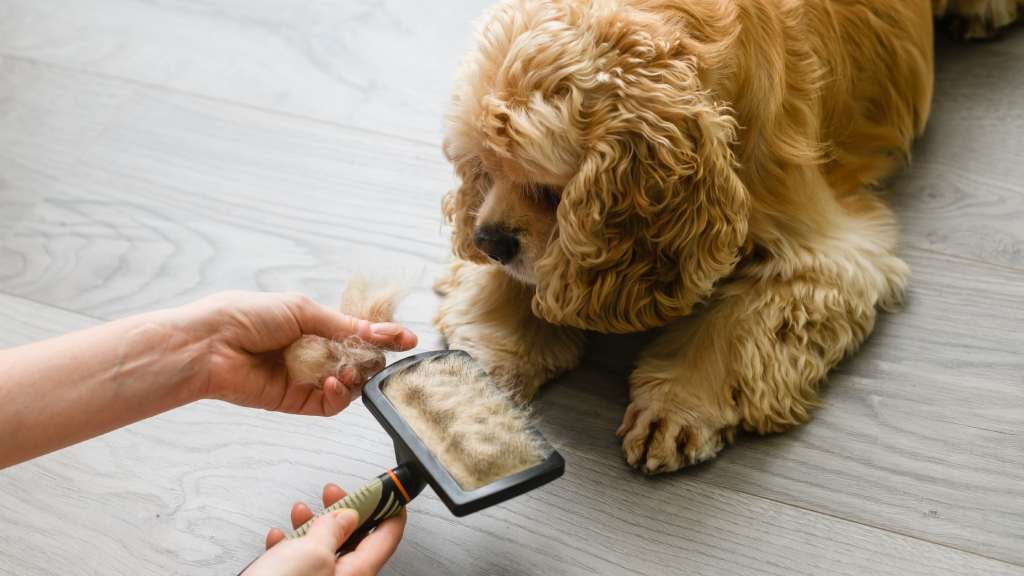Dr. Holly Boyden
BVSc (Merit) MANZCVS (ECC)

Warm fluffy cuddles with your fur-bestie? Yes please! Dog hair all over your clothes, furniture and home? Preferably not!
Dog shedding is normal in most breeds, but some are prone to shed more heavily than others. While there’s no miracle product to prevent shedding, there’s lots you can do to minimise the amount of loose dog hair floating around your home.
Read on to learn how to fight the fluff with your furry-friend!
All dogs shed to replace old and potentially damaged hairs with healthy new growth. This natural hair growth cycle involves phases of active growth, transition, resting and then shedding. Your pet’s hair growth cycle is influenced by factors such as:
Most dogs shed year-round to some degree, although ‘double-coated’ dog breeds (with a dense undercoat and a longer, coarser topcoat) such as Golden Retrievers, Huskies, German Shepherds, Border Collies, and Samoyeds will shed noticeably more in spring and autumn as they transition between lighter or denser undercoats for warm or cold weather.
Breeds such as Poodles, Bichons, Schnauzers and Maltese naturally shed minimal hair due to their longer hair growth phase, which is also why their fur requires regular clipping (unless you’re a fan of the ‘canine mop’ look!).
Normal shedding helps your dog to maintain good coat condition, although thicker-furred or double-coated breeds often require some grooming assistance to help clear out dead undercoat hairs and prevent matting.
Excessive fur loss or poor hair growth in dogs can be caused by either primary skin conditions (such as fleas, mites, skin infections or allergies) or other general health problems that affect the skin (such as hyperadrenocorticism (Cushing’s Disease), hypothyroidism, or poor nutrition).
Depending on the underlying cause, pets experiencing excessive shedding or poor hair growth may show symptoms including:
If you notice any of these symptoms in your four-legged friend, it’s best to have them assessed by your veterinarian. Having pet insurance may help toward covering the costs associated with required diagnostic testing and treatment for eligible vet bills, depending on the cover provided.
Although shedding is a normal process in dogs, many thick-coated or double-coated breeds will require regular coat maintenance to help remove dense undercoat and prevent matting, particularly in spring and autumn. Additionally, regularly grooming your dog can remove most of the loose hairs that would otherwise end up on your clothes or furniture (or blowing as hairy tumbleweeds around your house!) and keeps your pup looking their best.
Unless your pet has a diagnosed skin condition that your vet has recommended a specific program of medicated washing for, they should only require bathing about once every 4-6 weeks (or their coat smells or feels greasy or is dirty).
Washing your dog at suitable intervals can help to loosen any hair that is ready to come out without stripping healthy oils from their skin and coat. Ensure you use a gentle shampoo that is designed for dogs, as human shampoos can cause irritation due to their different pH.
Most dogs benefit from a brushing session once or twice weekly, using tools suited to their coat type. For very short-haired breeds, a grooming mitt or natural bristle-brush works well to remove loose hairs and skin flakes.
For thick-furred, long-haired or double-coated breeds, you’ll require an array of grooming tools to remove dead undercoat and detangle the topcoat – depending on your pet’s specific fur type, this may include a comb, slicker brush, and/or de-shedding tool. Take care to use de-shedding tools gently, as they can damage or remove healthy fur if overused.
Lastly, a healthy, balanced diet combined with supplements such as omega-3 essential fatty acids will support your dog’s skin health and coat condition to help reduce unhealthy shedding. It’s a good idea to consult your vet regarding personalised dietary recommendations for your pet.
Even with regular bathing and grooming, dogs will still naturally drop loose hairs, particularly those 'heavy shedder' thick-coated breeds such as Labradors, Golden Retrievers, German Shepherds and Huskies.
If having dog hair around the house bothers you, you can help to fight the fluff by:
Unfortunately, some people can develop allergies to proteins in pet dander (dead skin cells), saliva or urine, which are often carried on pet hair.
While some dog breeds are marketed as ‘non-shedding’ or hypoallergenic, it’s important to recognise that there isn’t any truly non-allergenic dog or cat breed. Every dog will shed at least some fur, although some breeds much less than others, e.g. Poodles, Schnauzers, Maltese or Bichons. These low shedding breeds are generally better tolerated by those with allergies.
If you or someone in your home has an allergy to dogs, it may be best to consult your doctor for personalised allergy management advice. However, exposure to allergens can be reduced by:
Although dogs bring boundless love and joy into our homes, they can also bring a lot of hair too! If you’d rather avoid fur-covered furniture, consider choosing a low-shedding breed or embrace regular grooming sessions to keep the shedding under control. And don’t forget to keep your vacuum close!
If you feel your dog is losing excessive amounts of fur, it’s best to consult your veterinarian for the best course of action for your fur-baby!
Consider pet insurance which can help cover unexpected eligible issues like skin conditions or vet visits if they occur while covered. Buddy Pet Insurance can help you provide the care your fur-bestie deserves.
11 Jun 2025